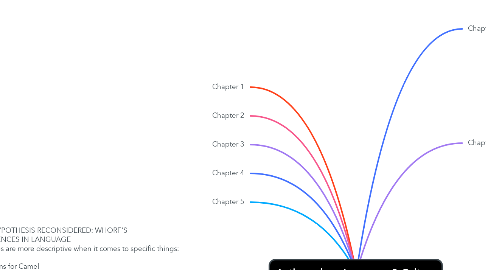
1. Chapter 1
2. Chapter 2
3. Chapter 3
4. Chapter 4
5. Chapter 5
6. Chapter 12: “ WHORF'S HYPOTHESIS RECONSIDERED: WHORF'S VIEW OF LEXICAL DIFFERENCES IN LANGUAGE • No doubt some languages are more descriptive when it comes to specific things: - Bedouins • Ex. They have various terms for Camel - Gender, breed, function, condition » What is the condition of this camel? - Aboriginals of Australia (Pintupi language) • Ex. Many words for holes - Pulpa-is a rabbit burrow - Katarta-is the hole left by a monitor lizard after it has broken the surface after hibernation • The concept may be expressed in smaller terms in some languages, but it is interpretable.” (Page 17)
7. Chapter 14 Language & Ideology : Class, Race, and Ethnicity: “INTRODUCTION Languages changes depending on situation and who is speaking. President inaugural speech vs. joking in a lock room Women’s garden party with hop-hop songs Speech and language can differ and is dependent on: Ethnicity-a broad term referring to a “racial,” national, tribal, linguistic, religious, and/or cultural affiliation. Gender-what gender you identify with Class-education, familial, and economic affiliation” (Page 4)
8. Chapter 6 Models of communication
8.1. "1940’s model of communication five components: • The sender (source) • The message • The channel • The receiver (destination) • The effect"
9. Chapter 7 life with languages
9.1. "Language acquisition device (LAD)-An inborn capacity of children to acquire their mother tongue without any formal attempt to teach it to them. Children are born with capacity for language or genetically built-in “core grammar” (1986). “Poverty of stimulus” (PS) Loose ideas about language Fragments of language Incorrect pronunciation Even with PS children learn Language."
10. Chapter 8 Language through time
10.1. "Language is recognized and investigated using the two following approaches. Synchronic approach-Dealing with linguistic phenomena as they exist at a specific point in time (that is, without regard for historical antecedents)(387). Diachronic approach dealing with linguistic phenomena as they occur over time (that is considering their historical development) (179)."
11. Chapter 9 Language in variation
11.1. Idiolects and dialects
12. Chapter 10 Ethnography Linguistic
12.1. speech community and related concepts
13. Chapter 11 Culture and Cognition
13.1. "Things in the world (referents) connect to words (symbols) connect in the mind (thoughts). (Page 9)
13.1.1. (9)
13.1.1.1. Conversational analysis is characterized by the following: 1. Examines conversations minutely in great detail; it is rigorous and empirical, and avoids grandiose theory construction. 2. The method is highly inductive. 3. A search is made for recurring patterns in large numbers of naturally occurring conversations (and not just based on single texts). 4. Emphasis is placed on the choices and alternatives available to speakers in differing types of conversations, and their interactional and inferential consequences. 5. Emphasis is placed on what is actually in the data rather than on what intuition might tell. us about what is or is not acceptable. 6. As many instances as possible of some phenomena under consideration are found across texts. (Page 33)
